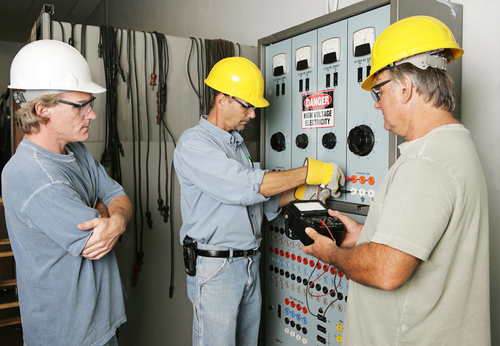Whenever electrical work starts, it’s time to review the National Electrical Code (NEC). This code book explains the many rules and requirements, while also providing guidelines for safety. When it comes to a new or replacement breaker panel, be sure to get started by choosing a location that conforms to NEC code.

Here we’ll discuss some basics for how the electric code affects our breaker panel. This goes for new construction and replacement panels. If you are adding a sub-panel, adding circuits, or rearranging circuit breakers in your panel, be sure to talk to an electrician to make sure the work gets done right — for your safety and so you’ll meet electrical inspection requirements.
Location and Clearance
Where should a breaker panel be located? Placement is the first important consideration. Primarily, it needs to be in a safe location and easily accessible. This means no bathrooms and no cramped spaces. The breaker panel must have 3 feet of clearance in front of it. If there’s plumbing nearby, the box should be weatherproofed.
Some more details:
- Breaker panel must be at least 4 feet off the ground, but no higher than 6 feet.
- The panel door must be able to open at least 90 degrees.
- Working space around the breaker panel must be at least 30 inches wide and 72 inches from the ground up.
- Furniture and other large objects cannot be blocking these clearances — in case of emergency, the breaker panel should be easily accessible without moving obstructions.
Grounding and Neutral Terminals
The NEC also provides numerous safety codes for proper breaker panel safety by defining how grounding and neutral terminals must be installed and connected. For instance, only one neutral conductor can be attached to each neutral terminal. The metal cabinet of the breaker panel must itself be connected to a grounding conductor.
There are numerous specific codes for the types of conductors used, methods for connecting wires and cables to terminals, and safe arrangement. Basically, every wire and cable must be safely connected!
Circuit Labeling
This is not optional — circuit breakers must be labeled. If yours are not marked or flipping a breaker does not turn off power to the area you think it should, talk to an electrician about figuring this out.
Labeling the breaker panel makes life a lot easier for you and your electrician, but it’s also a safety concern for first responders. Firefighters and other emergency personnel may need to shut off power and it’s best if they have labeled breakers to work with, particularly in multifamily buildings.
When in Doubt, Talk to an Electrician
Professionals can help make sense of all the rules. For example, you might be wondering if you can install a breaker panel in a closet. The answer is yes, as long as the closet is not in a bathroom. However, you would still need all the working clearance around the panel, so only a very large closet with empty space would be appropriate.
If you are adding a sub-panel to power a guest house or addition, or you need a new panel dedicated to a backup generator, definitely contact Spyrka Electric rather than just plugging everything in yourself!

